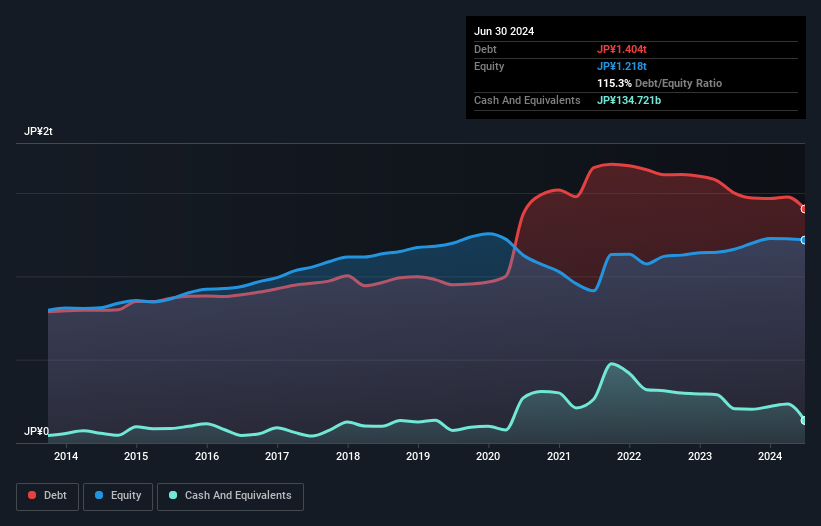- Japan
- /
- Transportation
- /
- TSE:9021
We Think West Japan Railway (TSE:9021) Is Taking Some Risk With Its Debt
Howard Marks put it nicely when he said that, rather than worrying about share price volatility, 'The possibility of permanent loss is the risk I worry about... and every practical investor I know worries about.' It's only natural to consider a company's balance sheet when you examine how risky it is, since debt is often involved when a business collapses. We can see that West Japan Railway Company (TSE:9021) does use debt in its business. But is this debt a concern to shareholders?
When Is Debt A Problem?
Generally speaking, debt only becomes a real problem when a company can't easily pay it off, either by raising capital or with its own cash flow. Ultimately, if the company can't fulfill its legal obligations to repay debt, shareholders could walk away with nothing. While that is not too common, we often do see indebted companies permanently diluting shareholders because lenders force them to raise capital at a distressed price. Having said that, the most common situation is where a company manages its debt reasonably well - and to its own advantage. When we examine debt levels, we first consider both cash and debt levels, together.
See our latest analysis for West Japan Railway
What Is West Japan Railway's Debt?
You can click the graphic below for the historical numbers, but it shows that West Japan Railway had JP¥1.40t of debt in June 2024, down from JP¥1.50t, one year before. However, it also had JP¥134.7b in cash, and so its net debt is JP¥1.27t.

How Strong Is West Japan Railway's Balance Sheet?
We can see from the most recent balance sheet that West Japan Railway had liabilities of JP¥645.4b falling due within a year, and liabilities of JP¥1.75t due beyond that. Offsetting this, it had JP¥134.7b in cash and JP¥149.8b in receivables that were due within 12 months. So its liabilities total JP¥2.11t more than the combination of its cash and short-term receivables.
This deficit casts a shadow over the JP¥1.29t company, like a colossus towering over mere mortals. So we definitely think shareholders need to watch this one closely. After all, West Japan Railway would likely require a major re-capitalisation if it had to pay its creditors today.
We measure a company's debt load relative to its earnings power by looking at its net debt divided by its earnings before interest, tax, depreciation, and amortization (EBITDA) and by calculating how easily its earnings before interest and tax (EBIT) cover its interest expense (interest cover). Thus we consider debt relative to earnings both with and without depreciation and amortization expenses.
West Japan Railway has a debt to EBITDA ratio of 3.7, which signals significant debt, but is still pretty reasonable for most types of business. However, its interest coverage of 10.8 is very high, suggesting that the interest expense on the debt is currently quite low. Importantly, West Japan Railway grew its EBIT by 58% over the last twelve months, and that growth will make it easier to handle its debt. The balance sheet is clearly the area to focus on when you are analysing debt. But ultimately the future profitability of the business will decide if West Japan Railway can strengthen its balance sheet over time. So if you want to see what the professionals think, you might find this free report on analyst profit forecasts to be interesting.
Finally, a company can only pay off debt with cold hard cash, not accounting profits. So it's worth checking how much of that EBIT is backed by free cash flow. Looking at the most recent two years, West Japan Railway recorded free cash flow of 36% of its EBIT, which is weaker than we'd expect. That's not great, when it comes to paying down debt.
Our View
While West Japan Railway's level of total liabilities has us nervous. For example, its EBIT growth rate and interest cover give us some confidence in its ability to manage its debt. Taking the abovementioned factors together we do think West Japan Railway's debt poses some risks to the business. While that debt can boost returns, we think the company has enough leverage now. There's no doubt that we learn most about debt from the balance sheet. However, not all investment risk resides within the balance sheet - far from it. These risks can be hard to spot. Every company has them, and we've spotted 2 warning signs for West Japan Railway you should know about.
When all is said and done, sometimes its easier to focus on companies that don't even need debt. Readers can access a list of growth stocks with zero net debt 100% free, right now.
Valuation is complex, but we're here to simplify it.
Discover if West Japan Railway might be undervalued or overvalued with our detailed analysis, featuring fair value estimates, potential risks, dividends, insider trades, and its financial condition.
Access Free AnalysisHave feedback on this article? Concerned about the content? Get in touch with us directly. Alternatively, email editorial-team (at) simplywallst.com.
This article by Simply Wall St is general in nature. We provide commentary based on historical data and analyst forecasts only using an unbiased methodology and our articles are not intended to be financial advice. It does not constitute a recommendation to buy or sell any stock, and does not take account of your objectives, or your financial situation. We aim to bring you long-term focused analysis driven by fundamental data. Note that our analysis may not factor in the latest price-sensitive company announcements or qualitative material. Simply Wall St has no position in any stocks mentioned.
About TSE:9021
Proven track record and fair value.
Market Insights
Community Narratives



